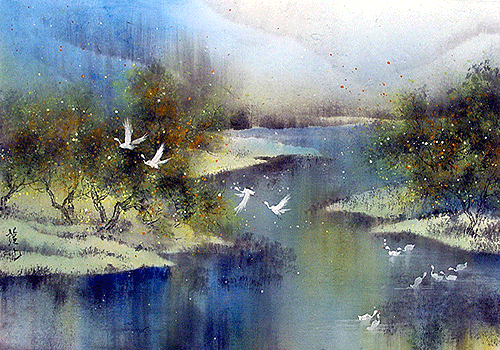|
|
||||||||||||||||||||||||||||||||||||||||||||||||||||||||
|
|
||||||||||||||||||||||||||||||||||||||||||||||||||||||||
|
SELECTED Articles | 0 | 1 | 2 | 3 | 4 |
Artist breaks away from traditionby Kevin Sullivan The Straits Times, Feb.14, 1985
For the past year. James Tan has been trying to break out of the traditional Chinese painting on which his reputation has, until now, been based. But he has not completely abandoned his earlier style of painting. I still keep at it. I never want to throw it away," he says.
Tan says the process of developing a fresh approach has not been easy. The experimental works are the tip of the iceberg, and much effort has gone into the wastepaper basket.
"Contemporary artists need time to develop images and ideas," he says. You have to take time to understand. It's very hard to let yourself out once you have developed traditionally. But once you do, you want to keep on in the direction you have to go."
That direction has result-ed in works which may surprise those who are acquainted with Tan's elegant Chinese brush paintings.
The predominant color of Landscape is black. Ink has been poured and sprayed on to a sketch in such a way that it roughly adheres to the pre-deter-mined composition.
The ink causes the rice paper to "bleed", creating blurred edges. The process of pouring and spraying is repeated to achieve variations in shade, and details are painted onto the finish-ed design.
Landscape is allusive, graphically effective and not at all overshadowed by the method which has been employed in its creation. It is from the latest stage of the artist's progress from his traditional roots per-haps the final stage.
It seems to have been preceded by a transitional phase, of which paintings such as Sunset are representative.
The design and composition are clear, but the end result is more decorative than forceful.
Snow, which depicts mountain, waterfall and fisherman in coracle, is a traditional painting, but it contains all the elements of the artist's experimental work.
Water, land and air are suggested as much as they are depicted. The curve or the foreshortening of a line creates the detail which fills out the picture, and the viewer's imagination is call to play.
Indeed, it becomes evident that the roots of the experimental work are to be found in very old tradition.
| BIOGRAPHY | ARTICLES | GALLERY | EVENTS | RECENT WORKS | ART COURSE | |
||||||||||||||||||||||||||||||||||||||||||||||||||||||||
|
||||||||||||||||||||||||||||||||||||||||||||||||||||||||

 About
a quarter of the 80 or so paintings in his cur-rent exhibition are in the
new style.
About
a quarter of the 80 or so paintings in his cur-rent exhibition are in the
new style.



